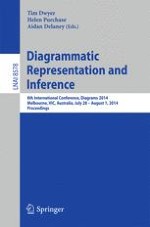2014 | Buch
Diagrammatic Representation and Inference
8th International Conference, Diagrams 2014, Melbourne, VIC, Australia, July 28 – August 1, 2014. Proceedings
herausgegeben von: Tim Dwyer, Helen Purchase, Aidan Delaney
Verlag: Springer Berlin Heidelberg
Buchreihe : Lecture Notes in Computer Science
